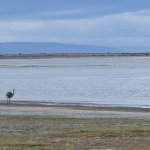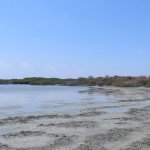Translated to English by WHSRN Executive Office
Read the story in Portuguese here.
Some shorebirds are adapted to grassland environments. This is the case of the Buff-breasted Sandpiper (Calidris Subruficollis), flagship species of the Sabanas de Paz de Ariporo and Trinidad WHSRN Site of Regional Importance in Colombia. Since 2015, the Asociación Calidris has regularly recorded about 500 individuals at the site, with a maximum number of 700, 1.25% of the estimated population size of 56,000 individuals.
Traditional cattle ranching is an essential component of the Colombian Llanos culture and today, thanks to the traditional practices that remain, it is possible to appreciate the great biodiversity of the savannas, including the Buff-breasted Sandpiper. Between March and April 2023, Joaquín Aldabe and Nicolas Marchand, Ranching and Shorebird Conservation Specialists at Manomet had the opportunity to visit the Colombian Llanos to learn more Asociación Calidris’s work with the ranching families that inhabit the WHSRN site.
One of the main threats at this site is the expansion of agriculture (e.g., increase in the area used for rice). Another threat is the mismanagement of fire which has led to the invasion of woody species that are favored by fire, such as the chaparro (Curatella americana).
This experience underscored the importance of continuing to support and connect ranching families throughout the hemisphere and along shorebird migratory routes by strengthening their productive systems in favor of nature, adding value to agricultural production that conserves biodiversity, facilitating access to incentives that reward those who produce while conserving, and disseminating successful examples of conservation and production. At the same time, we also can strengthen the opportunities for nature tourism, research, and sustainable development that these sites can offer to complement a family’s income.
These first steps have increased exchange and collaboration, as well as fostering opportunities to develop processes that help producers be more efficient in their productive systems while maintaining the natural focus of their production. This will protect the area from the agriculture expansion that includes conventional intensification activities that degrade natural resources.
Cover Photo: Nature Reserve Buenaventura farm in Altagracia in the Llanos. Photo: Nicolas Marchand.






